1968 German Grand Prix race report: Stewart finds no equal
Matra’s Jackie Stewart puts in a superlative wet-weather performance, winning by over four minutes
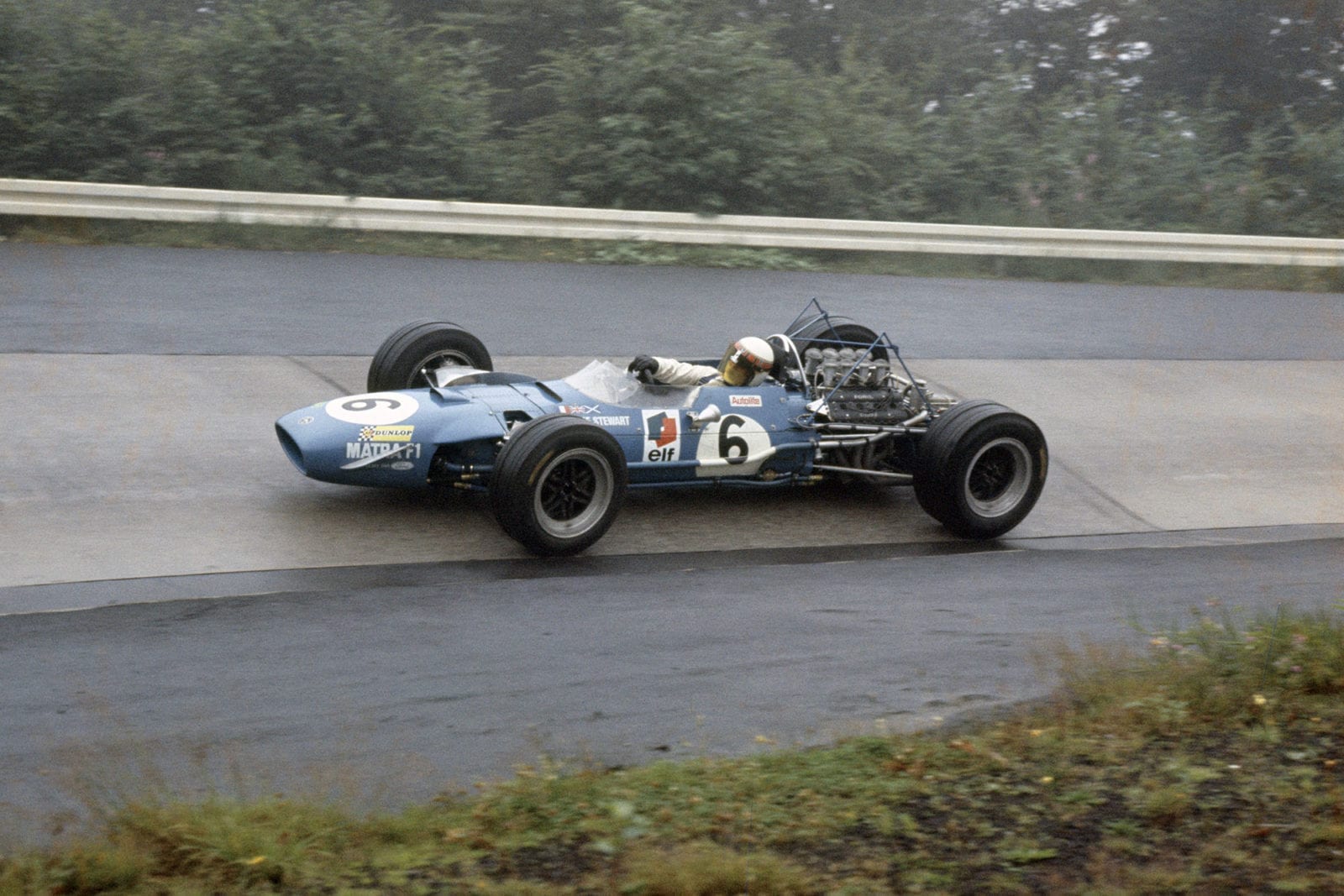
Jackie Stewart put in a peerless performance to win
Motorsport Image
As the Grand Prix “circus” converged on the Nurburgring through the Eifel mountains, Ferrari from Italy, Matra from France, Lotus, BRM, Brabham, Cooper and McLaren from England, and BMW from Southern Germany, the rain and clouds headed the same way; and like the “circus” they stayed for three days.
With the 1968 Grand Prix season over the half way mark everyone was well prepared and ready for a titanic battle, not only a battle against each other but a battle against the 22.8 kilometres of the Nurburgring, against the myriad of corners, the steep descents, the climbs up, the humps and the fast and slow straights.
Last year Clark had got round in a remarkable 8min 04.1sec, during practice and Gurney had set a race record of 8min 15.1sec, so that with twelve months advance, and Formula One cars are advancing rapidly in design, it was not so much as who was going to break eight minutes but how many, with the Ferrari, Lotus, Brabham, and Matra teams in strong contention.
Qualifying
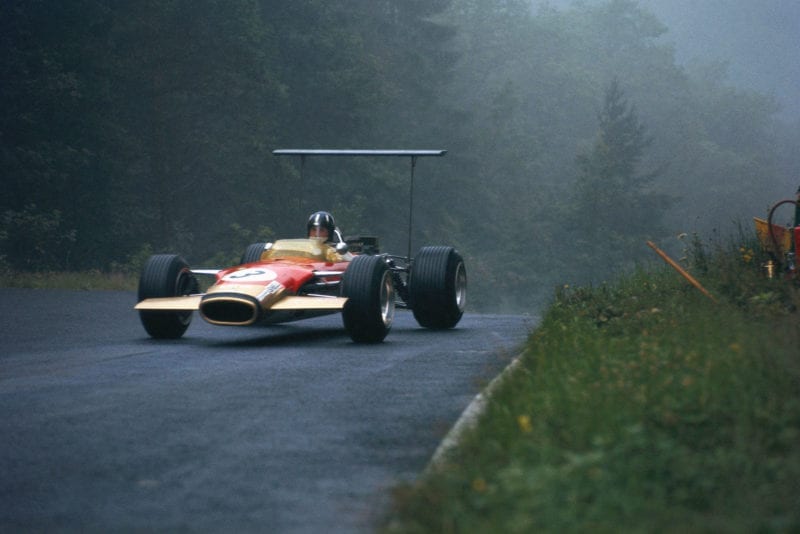
Hill’s Lotus team (amongst others) continued to experiment with new aerodynamics
Motorsport Images
However, it was not to be, for on Friday morning the weather clamped down and the only records that were broken were those for poor visibility and rainfall. The first practice was from 12 noon until 1:15pm on Friday, by which time the clouds were on the ground and were officially classified as fog!
For a time no-one was encouraged to set off round the full circuit, and those drivers who were at the pits and ready to go contented themselves with laps around the “pits loop”; down to the South Curve, back up behind the pits and through the gate before reaching the North Curve.
“On Friday morning the only records that were broken were those for poor visibility and rainfall”
With conditions steadily worsening they were finally given the OK to set off on full laps of the Nurburgring and among the keen ones who wasted no time were Hill, Surtees and Beltoise. Although practice continued for the allotted time it was a wet and soggy affair which proved nothing and provided no opportunity for any of the teams to learn anything or to make any serious progress.
Hulme and McLaren were looking disconsolate in the orange McLaren cars, only the latter carrying the aerofoil above the engine, and neither of them recorded any full timed laps. Hill in Lotus 49B/5, fitted with really massive drive-shafts to obviate the breakage troubles experienced in previous races, put in a number of full laps, his car equipped with the very wide nose fins and the high mounted rear aerofoil, but his team mate Oliver had to sit and watch as his car had not arrived.
Since Brands Hatch, where it ran in 1967 Type 49 specification, it had undergone a complete rebuild to 1968 or 49B specification, with forward-angled front wishbones, a Hewland gearbox replacing the ZF, and the rear suspension mounted on the gearbox instead of on the engine. The cockpit “monocoque” structure was the original from car 49/2, and all else was new so that it had become 49B/2. It was finished too late to leave on the big Gold Leaf Team Lotus transporter with Hill’s car, and arrived later on its own trailer behind a small van.
Brabham and Rindt had their 4-cam Repco powered Brabhams, and a brand new one was being finished off in the paddock, this being BT26-3. As they were so well equipped the Brabham team lent their 1967 type car BT24-3, to the young German driver Kurt Ahrens, his Caltex Racing Team looking after it, although they were never far away from Brabham in case guidance was needed.
The Tyrrell branch of Matra had the two Cosworth V8 powered French cars, and as Stewart was not 100% sure about the state of his damaged wrist, he had Servoz-Gavin standing by as reserve driver, the young blonde Frenchman having done over 1,000 kilometres of practice round the circuit in a touring car during the early part of the week. Stewart did quite a lot of laps of the “pits loop” but did not get in a full timed lap.
Surtees was one of the drivers to motor off into the gloom of the full circuit as soon as possible, driving the 1968 Honda V12 with its “aerofoil” remounted after the Brands Hatch episode, and this time not located so firmly to the chassis, allowing some flexibility like the Lotus system.
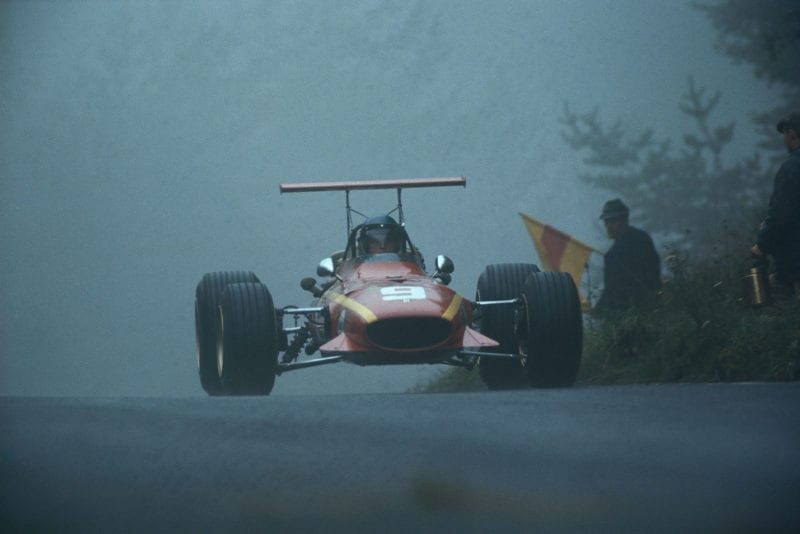
Ickx was driving the new Ferrari
Motorsport Images
Ferrari produced a brand new car, number 0015, to the 1968 specification, which Ickx drove, while Amon kept to 0011 and the French GP winning car, 0009, was in the paddock as a spare.
Rodriguez and Attwood were driving the works 12-cylinder BRM cars, as yet without aerodynamic assistance, as the Bourne brains have yet to be convinced, but Parnell’s BRM V12, which Courage was driving, was fitted with a nicely engineered “aerofoil” above the engine. This car also had the later type of alloy wheels which the works cars have been using, while Attwood’s car was fitted with a new design of rear wheel.
The works Matra team had their two 12-cylinder cars for Beltoise to use, the prototype having the six-pipe long exhaust system, and the newer car having a short four-pipe system, in line with Ferrari, BRM and Eagle thinking. The number two car was fitted with an “aerofoil” across the rear, mounted directly on to the chassis and it was pivoted so that the angle of incidence could be altered while in motion. The movement was effected electrically by a solenoid and a system of levers, the solenoid being energised by a circuit that was closed when the brake pedal was depressed. (For further details read Continental Notes).
Beltoise contented himself with full laps in the prototype car only. Gurney had the 12-cylinder Eagle that he drove so briefly at Brands Hatch, the half-hearted “aerofoil” being returned to its rearward mounting. Siffert was driving the Walker/Durlacher Brands Hatch winning Lotus 49B, it now having the small “spoiler” across the nose as used on the works cars, this breaking up the air-flow over the nose that had been creating “lift”.
From Munich had come a lone works BMW car, driven by Hubert Hahne, it having a Lola chassis and the powerful 2-litre radial-valve BMW engine, while Bianchi and Elford were driving the two works Coopers, the former in number one, the latter in number four, but there was still no sign of the long-awaited Alfa Romeo V8 engined car, although the 3-litre Italian engine had been giving good test-bed results, both as regards power and reliability.
Two absentees from this first wet and foggy practice were Bonnier and Moser, the former having withdrawn his entry, the latter not being ready. The abstention by Bonnier eased a tricky problem for the Automobile Club of Germany had accepted twenty-two entries and said that only twenty-one could start, the “odd man out” having to come from amongst Moser, Bonnier, Courage and Oliver. On principle no-one was in favour of this elimination of one car, so Bonnier was very popular with all concerned.
During Friday lunch-time everyone felt that conditions must get better, but they were all wrong, for by 3pm as the cars began to prepare for the second practice, due to take place from 3:15pm to 4:45pm, the clouds at ground level were getting thicker and rain was falling steadily.
Oliver’s Lotus had arrived, and Bianchi’s Cooper-BRM had been fitted with a very substantial “aerofoil” over the engine, this car retaining the totally enclosed nose cowling, whereas Elford’s car had ducted openings on cop of the nose for the exit of the radiator air, a system introduced this year by McLaren and followed by BRM.
Everyone stood around in silence, a vast crowd of spectators sheltering under umbrellas, until finally it was announced that all hopes of practice were gone and the organisation had reluctantly decided to abandon the day’s proceedings due to the impossible weather conditions.
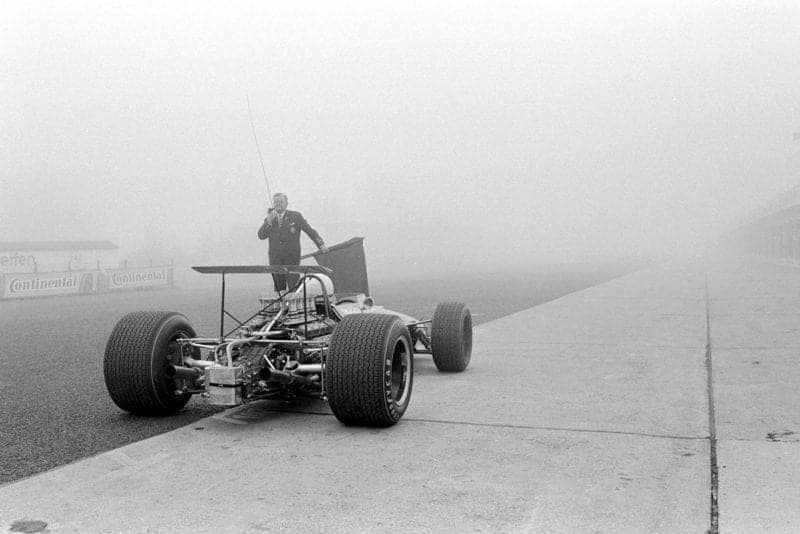
Poor Conditions limited running for Brabham and everyone else
Motorsport Images
As the cars returned to the paddock without so much as a lap of the “pits-loop” having been made, someone suggested that the drivers should challenge the team-managers to a game of football on the starting area in order to give the public some form of entertainment, for the crowds were remarkable in spite of the weather.
The whole day, that could have been so exciting in the dry, fizzled out in a wet and soggy atmosphere, the only consolation being that it was common knowledge that Eifel-weather seldom remained constant for very long. This was right enough, but not in the way people expected, for instead of improving the weather got worse on Saturday and by 12:45pm when Grand Prix practice should have started visibility was almost zero and the organisers were busy cancelling the supporting National races completely and sending the competitors home.
Around mid-afternoon there was a brief lifting of the fog and everyone was warned to be ready in 30 minutes, which they all did, but when they were given the “all clear” at 3:40pm the fog was returning fast. Rain water was flowing across the track in various places and drivers were warned to take it easy on the opening lap.
The wet and gloomy session went on until just after 5pm, by which time everyone had got in some full timed laps, except Moser whose Repco engine broke before he could leave the paddock. One or two drivers improved on their previous day’s times, but only because they had gone very slowly on the first day, while Ickx and Courage showed the true state of conditions by being one minute slower than their Friday time, both driving to the limit of the conditions on each day.
The Brabham team had made the most of the delays by getting their third BT26 finished and Rindt drove it around the “pits-loop” to bed things down. Cooper had fitted an “aerofoil” to their second car and Servoz-Gavin drove the V12 Matra number two as Beltoise could not be found at the beginning of practice.
Stewart made the fastest lap of the afternoon, his Matra-Cosworth carrying tubular struts for an “aerofoil” but the wing itself not being fitted, in a time of 10min 00.4sec, a full two minutes slower than he would have done in the dry, which gives some idea of the, conditions. With the official practice having been so disastrous the AvD agreed to there being a further period on the Sunday morning before the race, with a guaranteed minimum of three hours between the end of the extra period and the start of the race.
It would have been nice to be able co record that Sunday dawned bright and clear, but it was quite the reverse, the fog and clouds were still at ground level and rain was falling steadily. Practice was due to run from 10am to 11:45am but it was 10:25am before anyone got under way, Beltoise being the first to leave, driving the number two Matra V12.
The Ferrari team gave this practice a miss as there was little to learn and they had first and second places on the starting grid as a result of Friday’s practice anyway, there being little likelihood of anyone going any faster in the terrible conditions of Sunday morning. The BRM team also abstained, as did Courage and Siffert and the two Cooper drivers. McLaren and Hulme had not done a serious lap previously so they recorded improved times, as did Beltoise, Hahne and Oliver for the same reason, but Stewart suddenly stirred everyone up with a lap in 9min 54.2sec when few people could approach 10min 30sec. Then he did a lap with the “aerofoil” mounted above the engine and appeared quietly confident.
Brabham came in with an ominous ticking inside the right-hand inlet cambox, indicative of a broken cam-follower, or some such small but vital component in the valve gear, though not as serious as the “dropped valve” quoted so freely by his number two driver!
As practice ended and with the rain still falling Oliver slid off the road in his Lotus, on the descent to Adenau, and damaged front and rear suspension on the left side. When the car was returned to the paddock Chapman and the Lotus mechanics worked flat-out to replace the damaged parts, there being no time to worry too much about the geometrical settings, it being a real panic to get everything screwed on in time for the start. In the Brabham garages similar intense work was going on rectifying the damaged valve gear on the Repco engine.
Race
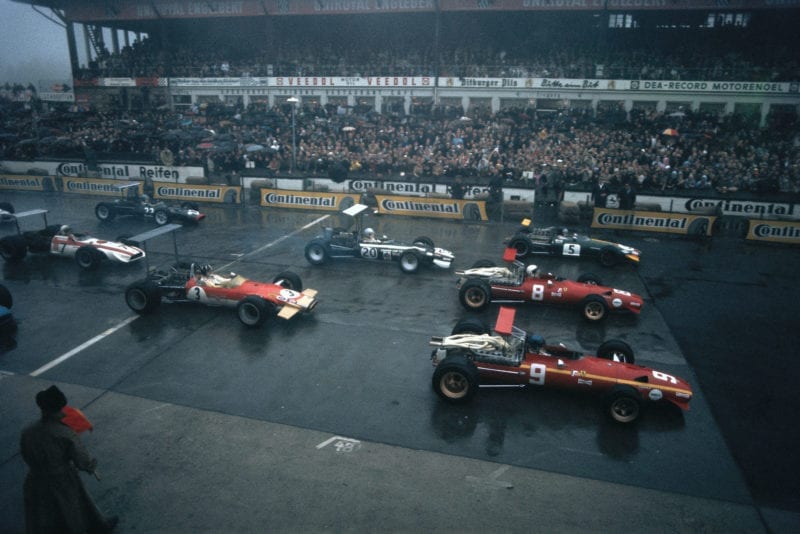
The cars line up in treacherous conditions
Motorsport Images
There was no sign of any improvement in the weather, and at first the start was delayed from 2pm to 2:30pm and then to 2:45pm, the organisation of the start being rather chaotic, for the cars were lined up on the main grid first, then having to be pushed back to the “dummy-grid”.
Both Hulme and McLaren were using “aerofoils” on their orange cars, the owner-driver being in his number one car in preference to the number three that he drove at Brands Hatch. Brabham and Rindt were in cars one and two, the new car not being used, Stewart was in the second of the Tyrrell Matras, complete with “aerofoil”, Surtees was in the V12 Honda that has been an “interim” car for so long this season that it has become “permanent”, Amon was in Ferrari 0011 and Ickx in the new one, 0015 Rodriguez was in BRM 133-01, reverting to the old type of wheels in order to accommodate the narrower wet-weather Goodyear tyres he was using, and Attwood was in 126-03.
Beltoise was driving the second of the V12 Matra cars, still with the brake-operated “aerofoil” and Gurney, Hill, Siffert, Oliver and Ahrens had no choice of cars, nor had Bianchi, Elford and Courage, but the last three were all using their new “aerofoils” as first tried in practice. The race was to be run over 14 laps of the North circuit of the Nurburgring, a total distance of 319.690 kilometres but at 2:45pm there was no sign of the start being given, and still none five minutes later.
The usual Nurburgring line-up of four-three-four-three on the grid had been wisely changed to three-two-three-two in view of the rain and fog, and shortly after 3:50pm the Cooper people on the back of the grid with Bianchi told him to start his engine, at the same time signalling to the mechanics with Elford on row two to tell him to start his.
They were worried about everything getting too cold with the hanging about, but when the two Cooper engines burst into file everyone else started up as well and the officials panicked and rushed for the 3-minute board and the starting flag, not having made a definite decision to start the race. The twenty wet and miserable drivers made the decision, as if they had said “Let’s get on with it” but though they all moved forward to the starting-grid the officials kept them waiting the full three minutes before the flag fell, by which time there was much over-heating going on, especially of Siffert’s Lotus and the Honda.
“With nearly 8,000bhp available on the grid and the rain pouring down the start was a moment of truth for Grand Prix racing”
With nearly 8,000bhp available on the grid and the rain pouring down the start was a moment of truth for Grand Prix racing, and every one of the twenty drivers excelled. They got away in a solid pack, spray flying in all directions and every reflex working overtime to get maximum acceleration and yet prevent too much wheelspin or any slewing about, for it is doubtful if anyone other than the front row could see anything at all.
When you have witnessed the clueless accidents that other forms of racing have achieved away from a start in perfect conditions with underpowered cars, you realise why the true Grand Prix drivers are the top of the driving profession, and the start of the thirtieth Grand Prix of Germany was a superb exhibition of ability.
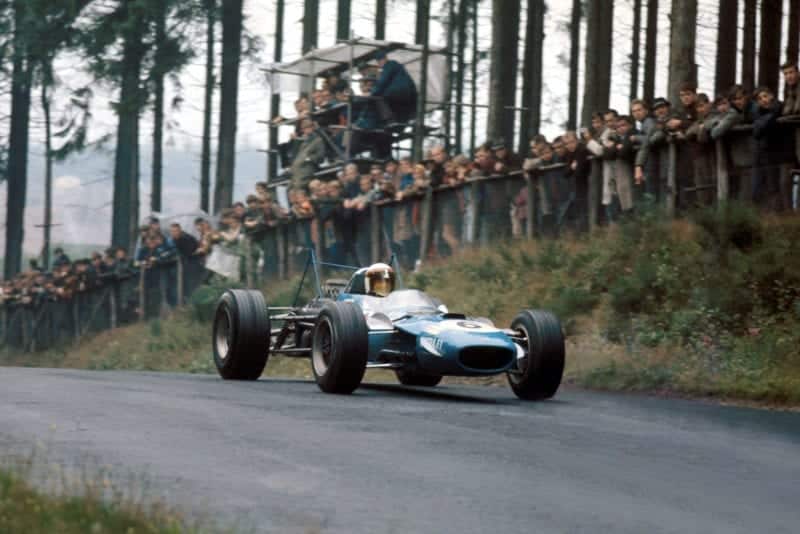
Stewart soon took the lead after starting 6th
Motorsport Images
The two Ferraris had hesitated for a fraction of a second, and Rindt had anticipated slightly so was off balance, but Hill made a superb start and shot through from the second row to lead the pack on the opening lap. With the rain coming down the choice of tyre was simple, so that everyone was on a more or less equal footing, but Stewart had a special set of “super-wet” Dunlops on his Matra.
Hill led as far as the exit from the long Schwalbenschwanz bends, when the blue Matra – Cosworth shot by him and disappeared in a cloud of spray, pulling out some ten seconds lead in the ensuing few kilometres to the end of the opening lap. On the same bends Elford lost control of his Cooper out of the climbing left-hander after the bridge and spun into the safety fence, wrecking the suspensions on the right side of the car and damaging the chassis, leaving him unhurt but unable to return to the pits until the end of the race.
“The standing lap by Stewart was really impressive in view of the conditions but there was much more to come from the Scotsman”
The lead that Stewart had at the end of the opening lap caused an audible gasp to be heard from under the mass of umbrellas in the public enclosures and then Hill, Amon, Rindt, Gurney, Ickx and Surtees followed through, except that the Honda was heading for the pits, its ignition system awry due to the overheating at the start, the torrential rain or a combination of both. Courage was just ahead of Brabham, followed by Hulme, Siffert, Rodriguez, Beltoise, Ahrens, Oliver, Bianchi, McLaren, Hahne and Attwood.
The standing lap by Stewart had been done in 10min 14.8sec which was really impressive in view of the conditions, but there was much more to come from the little Scotsman. At the end of the second lap the Matra was over 30sec ahead of Hill’s Lotus and Stewart was looking splendidly confident, while Amon was excelling himself and hanging on to the Lotus, being right in its spray as they passed the pits.
In previous wet races Amon had been thinking that he alone was unhappy with the conditions, not really appreciating that all the other drivers were hating the rain as well. He had obviously got over this mental block and was now going as well as anyone. Rindt, Gurney and Ickx were in close company and after a fairly long gap Brabham went by leading Courage and Hulme, with Siffert behind them, his Cosworth engine misfiring badly. A long time after everyone had gone by the unhappy Surtees in the miserable 12-cylinder Honda spluttered into the pits for yet another look at the ignition system.
On the third lap Ickx overtook Gurney around the Flugplatz area, to move into fifth place, and in his efforts to keep up the American clipped the bank on a right-hand corner on the climb to Hohe Acht too close and punctured his right front tyre on a protruding stone.
While the others raced on through the rain and the swirling cloud or fog, Gurney limped along on the flat tyre, to arrive at the pits in 12th position and drop to the end of the field by the time the wheel was changed. On this lap Hulme moved up a place, but it was only to seventh and with no hope of figuring among the leaders, and an unhappy McLaren was next to last.
Stewart’s pace was truly phenomenal, or else the pace of all the others was pathetic, but no-one lapping at over 80mph in the prevailing conditions could seriously be called pathetic. At the end of four laps the Matra had a lead of 59sec over Hill’s Lotus, which in turn was still being hounded by Amon’s Ferrari, while Rindt and Ickx were within striking distance.
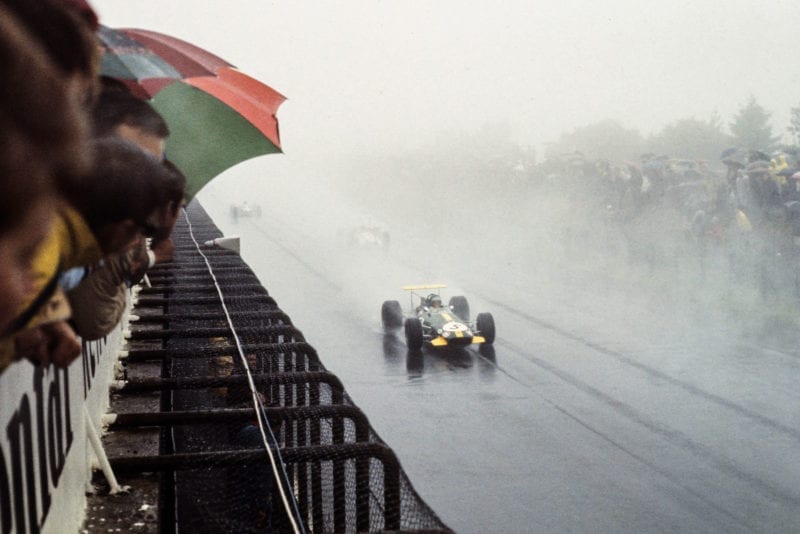
Rindt plunges through the spray
Motorsport Images
The rest were a long way back and Siffert drew into the pits to see if his misfiring could be cured; while Gurney was running well, but lying next to last, ahead of Attwood. On the next lap the pattern among the leaders was unchanged, but at the end of the field Hahne, with the 2-litre BMW, passed Ahrens with the 3-litre Repco-powered Brabham, and Gurney moved ahead of McLaren. Siffert had rejoined the race, a lap down, but as the misfire could not be cured he gave up after six laps, the trouble being attributed to the overheating on the start line.
On the same lap Bianchi came into the pits with petrol from a leaking tank swilling about in the cockpit, and was forced to retire. Stewart had covered lap 6 in 9min 41.3sec and was really at grips with the conditions, and was through the “pits loop” and round the North Curve before Hill and Amon could be heard approaching the start-and-finish area.
During this lap Ickx had spun off on the North Curve, got going again and spun on the next corner, and had completely lost contact with Rindt, but had not lost his fifth place. However, his visor had become mud-spattered and he could not see too well, so he stopped at his pit at the end of the seventh lap just long enough to hurl it to the mechanics.
Down the field Hulme was vainly trying to challenge Brabham, but Rodriguez had passed Beltoise and was about to overtake Courage, while Gurney had his sights on Oliver in 12th place, there being sixteen cars still running, Surtees having done one more faltering lap and then given up, the Honda once more proving to be a “dead-duck”.
Lap 8 saw Stewart with a new fastest lap of the day in 9min 36.0sec, a time that used to be very respectable in bright sunshine, and he had done it mostly in rain and cloud! By the end of lap 9 the Matra was swerving through the woods at Hatzenbach before the second-place Lotus was in sight of the pits, and on this lap Ickx made another quick stop at his pits to pick up his cleaned visor, having been driving with no eye-protection at all.
The overall order was still Stewart, Hill, Amon, Rindt, lckx, Brabham, Hulme, Rodriguez, Courage, Hahne, Gurney, Oliver, Ahrens, McLaren and Attwood, the last-named having been lapped by the leader. The Eagle and Ahren’s Brabham were both suffering from water in the electrics and were misfiring, and Beltoise was missing on this lap, the V12 Matra having slid off the slippery road near Hohe Acht.
“Wet and sad, Amon walked back to the pits to receive a thunderous ovation from the wet but enthusiastic crowds”
Stewart lapped McLaren during the 10th lap and Rodriguez was gaining rapidly on Hulme, although the World Champion did not know this and could see nothing in his mirrors because of his own spray. At the end of lap 11 Stewart was as confident as ever and just about to lap Ahrens, and the rain was falling as heavily as ever.
Amon was almost alongside Hill now, and it looked as though the New Zealander was going to move up into second place, for he had certainly overcome his inhibitions about driving in the wet. However, during the last few miles the Ferrari had been behaving erratically, as if something was going wrong with the differential, and on the South Curve he had a moment and lost contact with Hill. Rounding the North Curve something odd happened to the Ferrari and next moment it was off the road and Amon was out of the race, unhurt but certain that it had not been a driving error that caused him to run out of road. Wet and sad he walked back to the pits to receive a really thunderous ovation from the wet but enthusiastic crowds, fully appreciative of the splendid drive he had made.
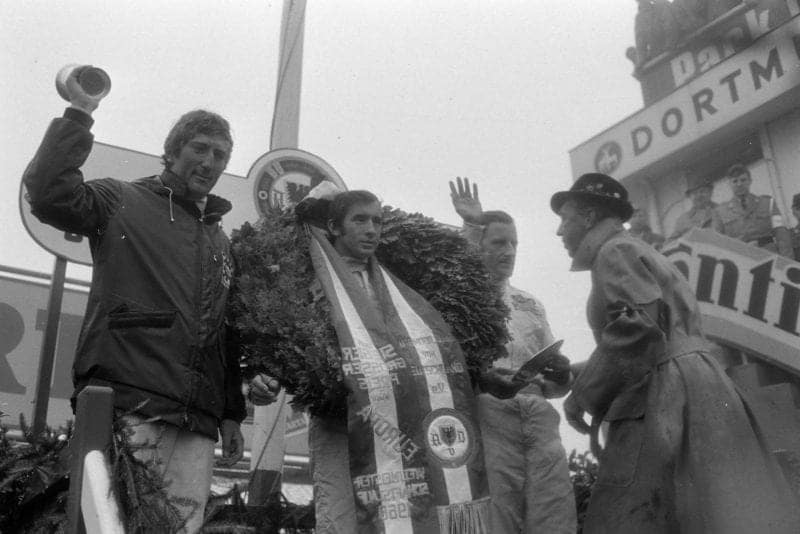
Stewart takes the plaudits after his superlative drive
Motorsport Images
The others splashed their way by, Rodriguez having moved ahead of Hulme, the McLaren driver not seeing the BRM until it was too late.
But the lap 12 drama was not finished for Hill had no idea that Amon had spun off and thought that the Ferrari was still somewhere in the cloud of spray that his giant rear Firestones were throwing into the air behind him. Going into the bends after Hohe Acht the Lotus got too far sideways and then round it went, Hill’s main concern being that he thought the Ferrari would run into him. He let the Lotus slide backwards across the road, the engine stalled, and as he came to rest he put on full lock so that the nose swung round out of the line of fire.
As Hill feverishly pressed the starter he was baffled by the non-appearance of Amon’s Ferrari, and the engine failing to start he climbed out and turned the car round by hand, rolling down the hill in the right direction. He leapt in, tried again, and breathed a sigh of relief as the engine spluttered into life and he was racing once more. All this allowed Rindt to close up to within sight of the Lotus but Hill was equal to the situation, and though the Brabham was only 2sec behind as they started the last lap Hill was confident of holding his second place.
The problem of the missing Ferrari was solved for him when he saw it beside the track. Meanwhile the magnificent Stewart drove on to one of his finest victories, his second for Matra this season, and both of them in the wet, but never has the Nurburgring thrown out a challenge like it had done this time, and the Grand Prix drivers, whether they had finished first or last, had risen to the occasion and fought back with every ounce of skill they possessed. It was miserable but magnificent.
Nurburg Rings
- Caracciola may have been the Regenmeisier, Rosemeyer the Nebelmeister and Fangio the Ringmeister, but Stewart surely topped the lot.
- Fair shares all round, Dunlop first, Firestone second, Goodyear third, fitted, respectively, to Matra, Lotus and Brabham; Autolite plugs and ELF petrol in the wining Cosworth engine, and Hewland gearboxes on all three.
- Despite the weather the crowds during the three days were remarkable, an estimated 200,000 being in the Eifel Mountains on race day. The police operated a splendid “one-way” road system which got everyone away afterwards very smoothly.
- Stewart’s race average for the 14 laps under the appalling conditions was 86.9 m.p.h.; I could not average that for one lap in perfect conditions, and I doubt if many of our readers could either.
- Attwood started last and finished last. Nothing pretentious there!
